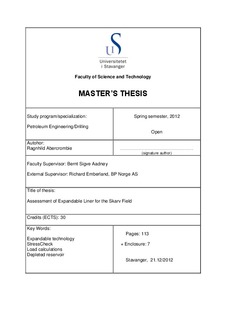| dc.description.abstract | BP’s Skarv field is a stacked three layer reservoir structure. The field development plan involves drilling deviated and horizontal wells into the uppermost reservoir layer, Garn, and the lowermost reservoir layer, Tilje. Above Garn is a high pressure zone, that requires 1.59 sg mud weight to be drilled. When Garn have proven to be a strong formation, the overburden and Garn is drilled as one section in Skarv drilling phase 1 to reach Tilje. A 9 7/8” shoe is set in top Tilje and the reservoir section in Tilje is drilled with an 8 ½” bit and left open hole and completed with gravel pack. The drainage strategy involves pressure support in Tilje, hence Garn will deplete with a faster rate.
In phase 2 Garn will have depleted to an extent that drilling with 1.59 mud will become a to large overbalance regarding differential sticking issues. The 9 7/8” shoe must therefore be set in top Garn. Due to the low pressure in Garn, Garn must be sealed off before drilling Tilje to avoid crossflow from Tilje into Garn. Garn and Ile, the middle sand, will be drilled with an 8 ½” bit. Traditionally a 7” liner will be set between top Garn and top Tilje. This will give a slim hole solution in the Tilje reservoir section which can lead to insufficient gravel packing resulting in hole collapse. It was proposed that expandable liner could be the solution to maintain an 8 ½” hole in Tilje. Available solutions for Skarv have been identified and Expandable liners from two vendors, Enventure GT’s SET® open hole liner and Baker Hughes linEXX™ monobore liner have been analyzed in StressCheck for installation, drilling and production loads an expandable liner could possible need to endure through the life off the well. Skarv’s J-4 well, Skarv basis of design, Skarv casing design, NORSOK and BP internal regulations are used to set up a model in StressCheck.
Expandables are special tubulars that are expanded down hole by mechanically or hydraulically pushing or pulling a cone or mandrel through the tubular. beyond the yield point, permanently deforming the pipe. When undergoing such expansion the mechanical properties of the pipes are changed. To gain a complete picture of what load scenarios the expandable must endure, the expandables were modeled both as pre- and post expanded.
The analysis includes five different pressure regimes and four different mud weights as drilling and displacement fluids. Pressure regimes were calculated based on the expected depletion rate in Garn and mud weight were calculated based on minimum required mud weight in relation to well stability. Output from the analysis are safety factors, SF. For Skarv, minimum required SF for burst and collapse loads are 1.10 and 1.00 for collapse. In general, the limiting factor for an expandable is the collapse strength. The results however show that the limiting factors for depleted Garn is related to the burst loading, when the liners internal pressure which is the weight of the mud and the applied surface pressure, as in a pressure test, will exceed the low external reservoir pressure. For the 7.625 X 9 7/8” SET® liner, the minimum SF was 0.93 for burst and 2.35 for collapse. For the 8.625 X 10 3 /4” SET® liner, the minimum SF was 0.88 for burst and 2.02 for collapse. For linEXX™ liner was 0.73 for burst and 1.32 for collapse. For all cases it was the high test pressure and injection pressures that casued the low SF. The internal pressure in a well is the pressure that can be controlled, which propose that expandables are a god solution for depleted reservoirs. By designing the well parameters to ensure the liners burst limit will not be exceeded, by e.g. tailor making the mud weight, expandable liner can be installed in Skarv wells.
The expandables are not easily modeled in StressCheck when it proved challenging to ensure the correct properties are input for the pre- and post-expanded pipes and combining the two. For StressCheck to be a reliable tool for expandables, vendor should supply exact numbers or a range for both the pre-and post-expansion properties as the input variables required in StressCheck. [...] | no_NO |
